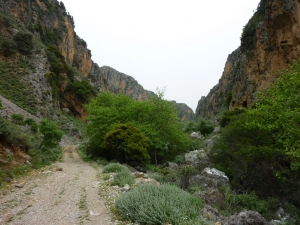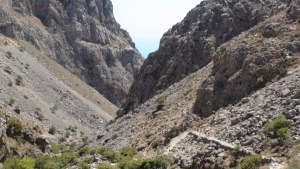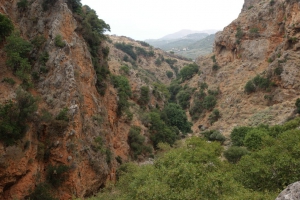For millions of years, the geological upheavals are reflected strongly in the intense relief of Crete. While mountains rose, the river water continued its corrosional route through the limestone terrain, forming today's "land of gorges", Crete. With more than 400 canyons, Crete hosts the largest number of gorges in Greece. Many travel agencies offer packages for gorge trekking and there is are several hiking and mountaineering clubs based in Heraklion, Chania, Rethymnon, Agios Nikolaos, Sitia, Ierapetra and Mires.
Cretan rivers meet large faults and steep descents during their course through the canyons, forming hundreds of small and high waterfalls. Crossing gorges of Crete with high waterfalls is possible only by using technical equipment. Appropriate training in canyoneering techniques can be offered by specialist companies on the island. The most popular technical canyons of Crete include the imposing gorge Ha, Tsoutsouras, Kalami, the gorge of Arvi (which after an 80m high fall turns into a dark underground river) and many more.

The gorge of Trypiti is formed at the range Asterousia, to the south of the village Vassiliki. The length of the canyon reaches 4 km and a beautiful pebble beach is formed at its exit. The beach is reached though a dirt road that runs high along the eastern side of the canyon for several kilometers before reaching its riverbed, just before the exit to the sea.

Astrakiano and Kounaviano canyons are two lush green gorges by Heraklion that merge near the village Skalani and carry on their united course till Karteros. The total length of the two canyons is about 21 km.

Deliana – Mesavlia Gorge is located 37km west of Chania. Starting from the village Mesavlia it descends to the village Deliana after 5km. Walking in the gorge is very easy (takes about one hour) and is suggested even for children, as it runs along a dirt road.

Kallikratis is a relatively small gorge in the southeast region of Lefka Ori (White Mountains) in Chania Prefecture. The gorge connects the mountainous pasture lands with the lowland villages. It is a very pleasant walk, offering great views and rare flowers, but is not very popular with tourists. The Kallikratis Gorge together with the Asfendou Gorge can be a full day’s excursion.

The gorge of Rocca, Roka, Rocka or Rokka is located 32km west of Chania, in the area of Kolymbari. The 2km gorge starts from the village Deliana and ends at the village of Roka. In the settlement there is Trouli hill, where you can still see the ruins of a Byzantine fortress.

The wild and imposing gorge of Kapsas is located 8-9km east of Makrigialos and 33km east of Ierapetra. The gorge is also called Pervolakia, because its northern entrance is near the secluded and picturesque village of Pervolakia. When in the village, you should walk in the nearby traditional village of Pezoulas, with the amazing houses.

Sirikari is located 55km west of Chania and 17km south of Kissamos, in a lush green area with canyons and water streams. The road to Sirikari is paved and runs through the dense vegetation, indicating the beauty of the area at the very first moment. From here begins the beautiful canyon of Sirikari leading to the settlement of Polirinia, where the ancient town of Polirinia was built.

Tripiti is the second large gorge parallel to Samaria gorge and, like Klados, the trail heading to its entrance also starts at Linosseli spring. In order to approach its entrance there is a dangerous passage where you risk getting stuck, so that you can neither walk on nor turn around and go back. Therefore, you should never attempt to cross this place it without the escort of an experienced hiker.











































































